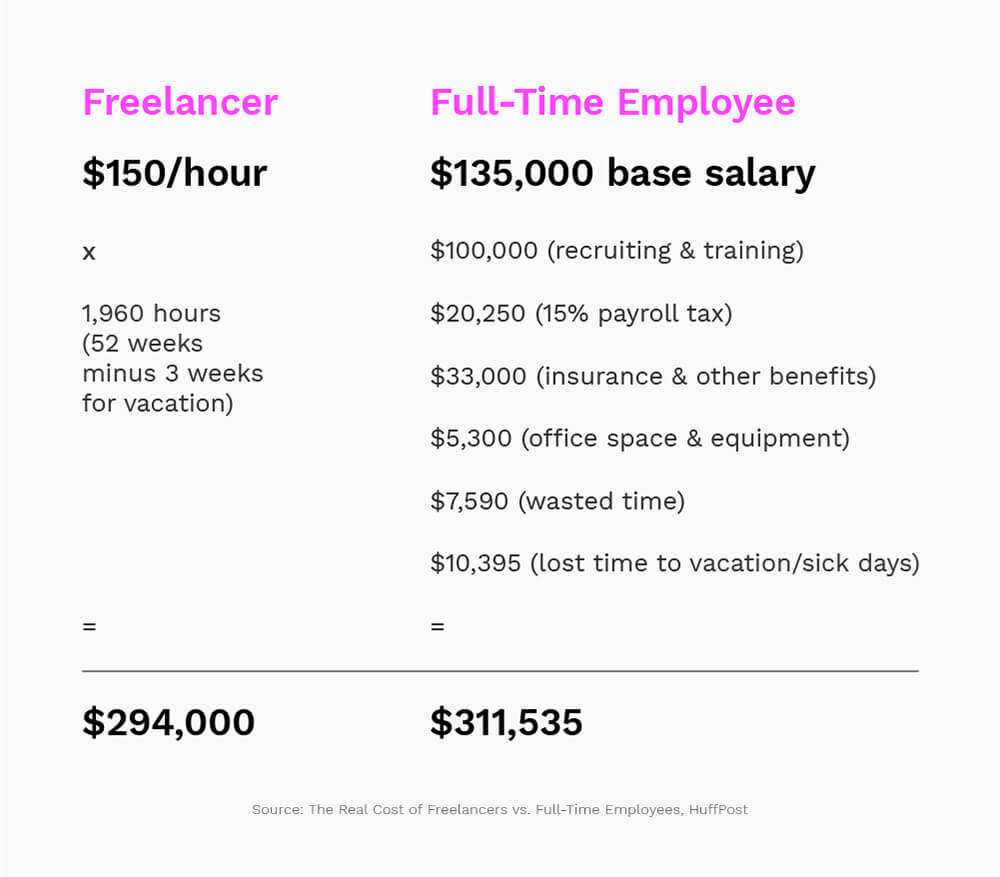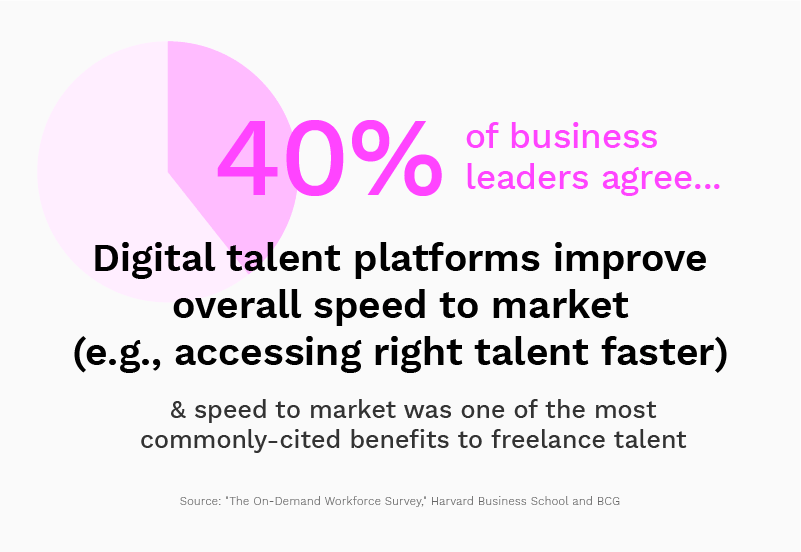- You can’t get the best out of freelancers until you’ve honed your management processes. And the key to good management — freelance or otherwise — is communication.
- Clear communication up front, and continuing conversation through regular check-ins and transparent project management helps streamline workflows and prevent confusion.
- Invest in the right strategy powered by the right expert freelancer and you’ll see a return.
In many ways, freelancers are easier to hire, manage, and let go than full-time employees. Just ask Rand Fishkin. The co-founder and CEO of SparkToro, who previously co-founded Moz, gives consultants an edge over agencies and full-time employees in a recent blog post.
Consultants outdo their competition on several dimensions, Fishkin argues. They achieve productivity more quickly; they cost less in total, and they’re a more flexible cost; they require less emotional investment from their employers; and they take less time and effort to replace.
In fact, when first launching, SparkToro opted to outsource talent rather than add more in-house team members. The company hired four agencies and five consultants in its first two years.
Of course, managing a freelancer is not the same as managing a full-time employee or agency. Before you begin working with your first freelancer, it’s a good idea to have project management strategies in place to help you make the most of their expertise.
Below, we collected insights on managing freelance marketers from several experienced freelancers and marketing managers.

Source: “The Real Cost of Freelance vs. Full-Time Employees”
What is a freelancer?
Any professional working as an independent contractor on a full-time, part-time, or hourly basis is considered a freelancer. They may be self-employed, or they may be full-time employees who offer freelance services on the side.
For instance, one expert freelancer on MarketerHire’s premium platform has a full-time marketing position at Postmates while also freelancing with other DTC brands in his free time. Current and former marketers from Dollar Shave Club, Netflix, and Amazon also freelance through our platform.
Who hires freelancers?
Some of the top companies in America plan to assign an increasing number of projects to freelance workers. In a survey published in 2020’s “Building the On-Demand Workforce” report from the Harvard Business School and Boston Consulting Group (BCG), 60% of business leaders said they expected to increasingly “rent” “borrow” or “share” talent with other companies.
That’s in part because, as Fishkin also noted, freelancers boost agility.

Source: “Building the On-Demand Workforce”
The rise in premium talent marketplaces, such as Toptal for tech and MarketerHire for marketing, is helping small businesses and fast-growth startups keep up with the rising demand without sending quality down the tubes.
But ultimately, every company will hire freelancers or lose their edge, predicts interim Cameo CMO Greg Caplan.
Is the freelance industry growing or fading?
It’s growing. In 2020, more than a third of Americans freelanced — up 22% from 2019, CNBC reports.
In 2020, more than a third of Americans freelanced — up 22% from 2019, CNBC reports.
That’s in part due to the global coronavirus pandemic, which led to sweeping 2020 layoffs — and forced many unemployed people to freelance to make ends meet.
It’s also due to the increasing ease of earning passive income from affiliate marketing and low-lift, no-code creator marketplaces like Gumroad, Patreon, and Substack — which has made freelance work more attractive for 9-to-5ers.
The rising number of freelancers doesn’t seem temporary, either. Freelancers increasingly see self-employment as a viable long-term option.
Employers see hiring freelancers as a viable long-term option, too. During the pandemic, startups like Outer — one of the country’s fastest-growing DTC brands — and Trend — which saw 250% GMV year-over-year growth in 2020 — used premium freelance talent to scale marketing without scaling full-time employees.
Why you should (or shouldn’t) work with freelancers
After learning about Fishkin’s past hiring experiences, we decided to do our own analysis on the subject — comparing full-time marketing employees to outsourced agency and freelance talent.
Here’s what we see as the biggest pros and cons of freelancers:
NOTE: Because we rigorously vet our marketing freelancers and typically accept only five percent, these conclusions are based on our experiences with expert freelancers, not your run-of-the-mill marketing generalist with minimal experience.
The pros of expert freelancers
- They can start promptly.
- They can hit the ground running.
- They’ve seen your tech stack before — especially if you’re a DTC brand.
- They’re agile hires.
- They have stellar resumes.
- They’re a flexible expense.
The cons of expert freelancers
- They can be tough to integrate into existing systems.
- They can quit suddenly.
How do you hire freelance marketers?
People over-complicate hiring, according to digital marketing thought leader Neil Patel. In a Marketing School podcast episode, he and co-host Eric Siu offered advice on hiring marketers in 2020. Patel believes hiring should involve less job postings and more test projects.
“I would just test people out as contractors and see who works,” Patel said. “And then from there, double down on the people who are working.”
Patel gave similar, step-by-step advice in his video on hiring great employees and his article on recruiting top marketers:
- Look for people who’ve achieved the results you want at a similar organization.
- Ask for referrals (and work samples).
- Present them with situations to see how they think through problems.
- Slowly introduce them to the team and clients.
- Give them a few paid projects first to see how they do.
Remember, relationships go both ways. You need to gain a freelancer’s trust as much as they need yours.
If you have time to hire slowly, you could start by building relationships on LinkedIn; Patel notes that Vidyard used this tactic to hire top talent from FreshBooks.
However, speed is often a must for hiring managers bringing on a marketer. That’s because marketers help stagnant businesses revive awareness and fast-growth businesses keep up with demand. They are also notoriously overworked and overstressed — so the marketing manager is likely drowning in work by the time they get the green light to hire or onboard a freelancer.
If you need a marketer ASAP, you can sort by project or title on freelance marketplaces. The downside here is without strict qualification requirements, it’s hit or miss. You’ll need to vet these yourself as many marketplaces don’t have set requirements for freelancers on their platform.
If you want pre-vetted, top 5% marketing expertise, MarketerHire matches companies to expert marketing freelancers for free. And we’ve worked with the best — Netflix, AllBirds and Outer.
Where do you find freelancers?
Search Google, LinkedIn, Facebook, Twitter, or countless freelancer marketplaces — it’s hard not to find freelancers. Many freelancers and small business owners optimize their personal social media pages to better advertise their services.
However, calling yourself a freelancer doesn’t require any particular qualifications, and that makes it hard to sort experts from amateurs.
The good news: anyone can freelance.
The bad news: anyone can freelance.
The good news: anyone can freelance. The bad news: anyone can freelance.
Remember: Not every job title and growth claim you read on the internet is real.
Popular places for finding freelance talent
To avoid misses and reduce wasted time, we recommend finding freelancers through referrals, rather than straight-up platform searches. There are a couple ways to go about this. You could:
Ask your network on…
Ask online communities like…
- Quora
- Facebook groups
- Slack channels
- Freelance marketplaces
Find pre-vetted freelancers on platforms like…
- For tech talent: TopTal
- For marketing talent: MarketerHire (sure, we’re biased, but our reviews and case studies back this up)
- For finance: Paro
What motivates freelancers?
To answer that, you need to understand how remote employees and freelancers work, and what motivated them to become freelancers in the first place. Good management starts with empathy.
“Companies who want to have successful working relationships with contractors should find out exactly what their skill sets are and then leverage those skill sets. Often you’re getting more than you think,” Lauren Lang, an independent content strategy consultant, told MarketerHire.
The gig economy is gaining steam. 24 million Americans consider abandoning their careers for self-employment, according to FreshBooks’s 2019 Self-Employment in America Report. Why? For 40% of them, control over career is the driving factor — including the freedom to choose their own clients, hours and location.

Source: “2019 Freshbooks third-annual Self Employment in America Report”
How can knowing the motivations behind self-employment help you better manage outsourced projects? Happy freelancers make for better working relationships and better work. If you want to get the best work out of your freelancer, consider:
- Remote work
- Flexible working hours
- Not expecting them to be on call 24/7
- Asking the extra question to better understand their specialties and approach
- Assigning projects based on their availability and strengths
- Treating them as colleagues, not subordinates
Below, we dig deeper into optimal freelancer management strategies.
How to interview freelance marketers
It’s impossible to achieve goals you never set — so define and communicate your objective and scope of work in the first interview.
What does a win look like? Maybe it’s a 10% increase in email sales in Q1 — but is that a year-over-year increase, or a quarter-over-quarter one?
Get specific about your project, deliverables and desired outcomes. Review marketer job descriptions to better understand standard skill sets of different marketing specialties, and tailor your interview questions accordingly. Be sure to ask them about past roles, projects and results.
At the same time, Preston Wickersham, a senior content marketing manager at Remote.com, recommends that marketing managers stay open to feedback. “If you want some blog posts but your website is a mess,” he said, “your content marketing freelancer may have some great advice on how to set up your site for success instead of throwing money away on posts that won’t rank.”
How to onboard freelance marketers
Good freelance management starts with good leadership.
“With freelancers, the guardrails I implement depend entirely on the level of expertise the freelancer has, and the extent of my relationship with them,” founder and CEO of Lantera Labs Aneesha Rao told MarketerHire. “With an experienced content or design marketer, I let them have at it, and give a basic schema of project scope.”
“With freelancers, the guardrails I implement depend entirely on the level of expertise the freelancer has.”
According to Kaleigh Moore, a freelance SaaS and e-commerce writer, the best freelance marketers are very clear about what they want and their ideal target audience (B2B or B2C? E-commerce or service-based? What verticals?). They should have a solid, easy-to-navigate onboarding process for new clients
“They’re also really good at communication and are always happy and available to answer questions,” she said. “They have all of the important strategy details ironed out before they dive into a new project and have metrics in place that serve as benchmarks rather than just winging it.”
But even the best marketers need structure. And they need help to get onboarded to your tools and introduced to your team. That’s why we recommend an onboarding checklist.
Erin Balsa, head of content marketing at The Predictive Index, has been hiring freelance writers since 2011 and managing them since 2015. Her secret? She shares an onboarding document with every new freelancer. “It summarizes and links out to everything they need to get started fast: brand guide, writing guide, linking policy, feedback process, product tours, product messaging docs,” Balsa told MarketerHire.
Different freelancers require different onboarding materials, but our Marketer Onboarding Workbook will give you a good head start with a checklist, timesheet, and helpful training resources.
Check out our Marketer Onboarding Workbook to get started.
How to begin outsourcing work to a freelancer
So you’ve hired a freelancer and kickoff day’s around the corner. What do you do? In a nutshell, “(over)communicate to avoid unnecessary revisions,” Monica Maria, SuperOps.io Content Marketing Manager, told MarketerHire.
Here’s what good communication looks like when managing freelancers:
Give freelancers access to needed contacts.
For marketing, these might include subject matter experts, direct reports, full-time employees and existing agencies.
Share buyer personas and brand/style guides.
Don’t have these? Consider hiring a Brand Marketer.
Develop a file-sharing system.
We recommend setting up a shared Google Drive or Dropbox folder.
Ask your tech team to grant freelancers access to needed software.
Not sure when this applies? We find 20+ hours per week or a month-long engagement warrants access to internal communication channels like Slack and project management systems like Asana.
Set up your project management tools ahead of time
- Common task management set up: Kanban (card view)
- Common column labels: “Ideas,” “To-Do,” “In Progress,” and “Done.”
- The best free project management apps, according to Zapier: Trello (for visualization), Asana (for freelancer teams), and ClickUp (for custom task view)
Share design assets.
These might include logos, templates and brand images.
Offer relevant marketing examples.
Every company has its own dos and don’ts — and your brand guide will cover some of this. But it also helps to include some project-relevant examples of what you do and don’t like, Rao observed.
Set up a calendar for regular check-ins and deadlines.
- Find a time for 1:1 weekly standups with your marketer. In these, you can touch base about the project’s current status, milestones, hours, deadlines and any new instructions.
- Onboard the marketer onto your company time-tracking software. Don’t have a time management system? We polled freelancers on LinkedIn about their favorite freelance tools, and Toggl (which includes a time-tracking tool) was a top-five favorite. Just in case you don’t need the hassle of another SaaS tool and want to keep it simple, you could also try our free Google Sheets time tracker.
- Pad deadlines. With freelancers, stuff often comes up. So if you need deliverables turned around in 72 hours, ask for it to come in 48. You don’t want to create a situation where a miscommunication would lead to catastrophe.
How much does it cost to hire a top freelance marketer?
Okay, let’s get down to brass tax. You understand the benefits and drawbacks of freelancers and you’re ready to either get started or get better at managing them. But first, you need to find them. And not just a freelance marketer, a proven marketer who just happens to freelance. Because an expert will make all of the above easier. Why? Because they’ve done it before. They have the templates, time trackers, project history, and people skills.
Freelance marketers’ rates vary widely — from too-cheap-to-be-true to outlandishly high. At MarketerHire, though, general pricing for expert marketers fall into the following ranges:
Hourly: $80-$160+/hour
Part-time: (20% discount for 20-hour commitment): $1,200-$2,400+/week
Full-time: (20% discount for 40-hour commitment): $2,400-$4,800+/week
Conclusion
You can’t get the best out of freelancers until you’ve honed your management processes. And the key to good management — freelance or otherwise — is communication.
“If you communicate with someone one-on-one, set expectations, and invest time in building a relationship, it’s like any other relationship,” said Rao. “I happen to think that culture is created everywhere, and regardless of whether or not someone is in-office, remote, a contractor, or employee, they’re contributing to your team and organizational culture.”
Clear communication up front, and continuing conversation through regular check-ins and transparent project management helps streamline workflows and prevent confusion.
Invest in the right strategy powered by the right expert freelancer and you’ll see a return.
But first:
- Provide clear expectations and healthy boundaries
- Integrate freelancers into your workflow
- Develop a calendar and communication plan
Good news: We have the marketing talent and freelancer onboarding resources to make all that easier.


 Dr. Gleb Tsipursky – The Office Whisperer
Dr. Gleb Tsipursky – The Office Whisperer Nirit Cohen – WorkFutures
Nirit Cohen – WorkFutures Angela Howard – Culture Expert
Angela Howard – Culture Expert Drew Jones – Design & Innovation
Drew Jones – Design & Innovation Jonathan Price – CRE & Flex Expert
Jonathan Price – CRE & Flex Expert
















